Living Root Bridges in Meghalaya are home to one of the longest known living root bridges in the world, stretching over 150 feet across. These special bridges are found in the green, hilly forests of northeast India. Unlike regular bridges made of steel or cement, these are made from the living roots of rubber trees.
For generations, the Khasi and Jaintia tribes have gently guided these tree roots across rivers and streams. Over many years, the roots grow long and strong enough to carry people safely. These bridges take 15 to 30 years to grow, but the great thing is—they don’t break down with time. In fact, they become stronger as they grow older, and some are even more than 100 years old!
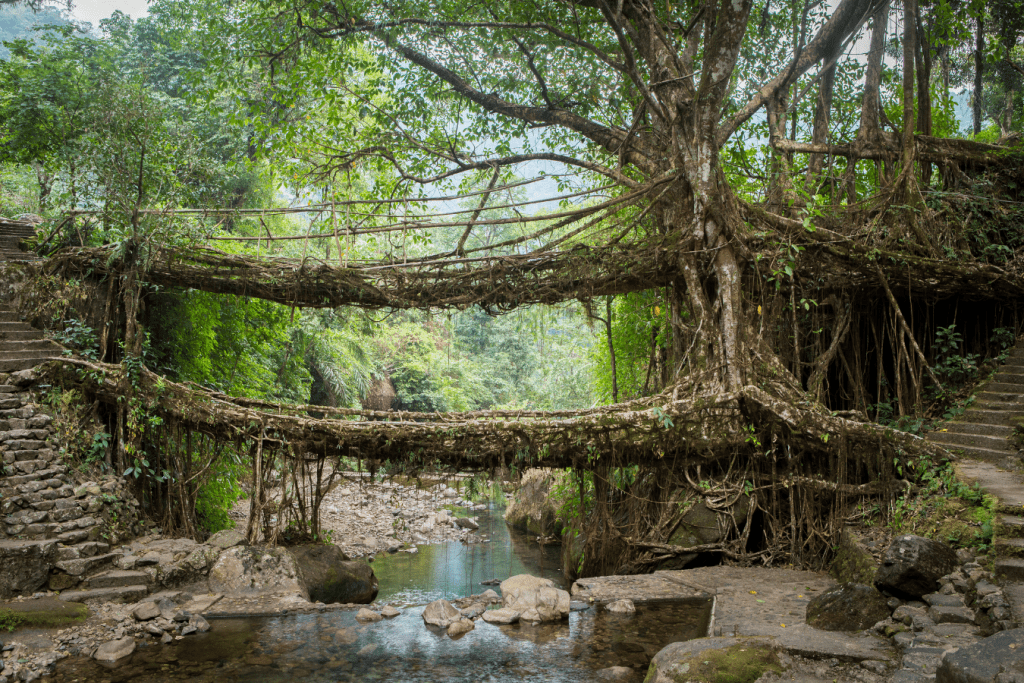
One of the most famous bridges is the Double Decker Root Bridge in Meghalaya Nongriat village. It has two levels, one on top of the other. This clever design helps people cross even when the river below floods during the rainy season. Today, it’s one of the most visited places in Meghalaya and shows how people and nature can work together in a smart and beautiful way.
More and more travelers are coming to see these natural bridges. But before visiting, many people have questions, like:
- When is the best time to go?
- Is the trek safe for beginners?
- How long does it take to reach?
- How are these bridges made?
- Can you sit, eat, or rest there?
- What else can you explore nearby?
This guide will answer all of these questions. You’ll learn how the bridges are made, when to visit, how to reach them, what to do there, and all the special things you’ll enjoy on this unique journey to the Living Root Bridges in Meghalaya – Where Trees Become Bridges.
What Makes the Living Root Bridges Special?
These bridges are not just built—they’re grown. The roots of special rubber trees are slowly guided across streams and rivers by the local people. Over many years, the roots grow long and strong enough to become real bridges that you can walk on.
One of the most amazing things is that these bridges don’t get old and weak like normal ones. In fact, they become stronger with time. Some are more than 100 years old and still used every day!
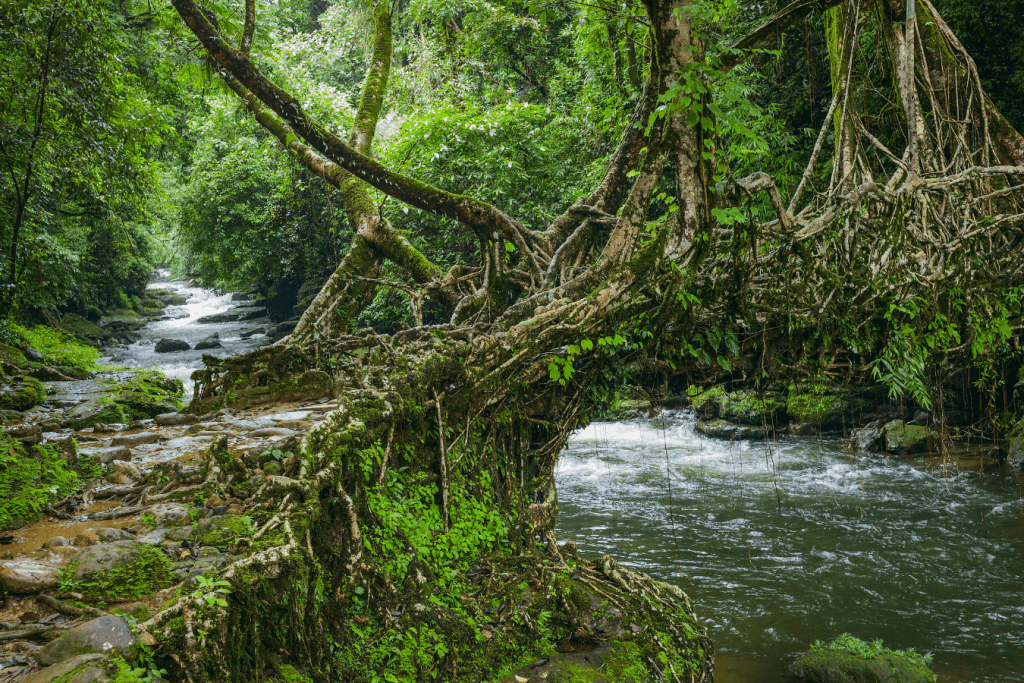
You won’t find these bridges anywhere else in the world—they exist only in Meghalaya, hidden in the green hills of the Khasi and Jaintia regions. The bridges are a perfect mix of nature and human care, and they show how people can live in harmony with the forest.
Walking on one feels like stepping into a fairytale. It’s peaceful, magical, and something you’ll never forget.
How Are the Living Root Bridges Made?
In the deep valleys of Meghalaya, the local tribes don’t build bridges — they grow them. It all starts with a young rubber tree planted near a river or stream. From this tree, long roots begin to hang down and stretch outward.
The villagers gently guide these roots using tools like bamboo or wood, helping them cross over the water. The roots are trained little by little, season after season, until they reach the other side and take hold in the soil.
Over many years, the roots twist and weave together naturally, forming a bridge strong enough to hold people. No nails, no cement — just time, care, and nature doing its work.
This quiet, patient method has been used for generations. It’s a beautiful tradition that shows how humans can shape the natural world without damaging it — just by working with it.
Best Time to Visit the Living Root Bridges
The best time to visit the Living Root Bridges in Meghalaya is during the dry months, from October to April. During this time, the weather is pleasant, the skies are mostly clear, and the trails are easier to walk.
If you visit between November and February, you’ll enjoy cool, fresh air—perfect for trekking. It’s also a great time for photography, as the forests look lush and green without being too slippery.
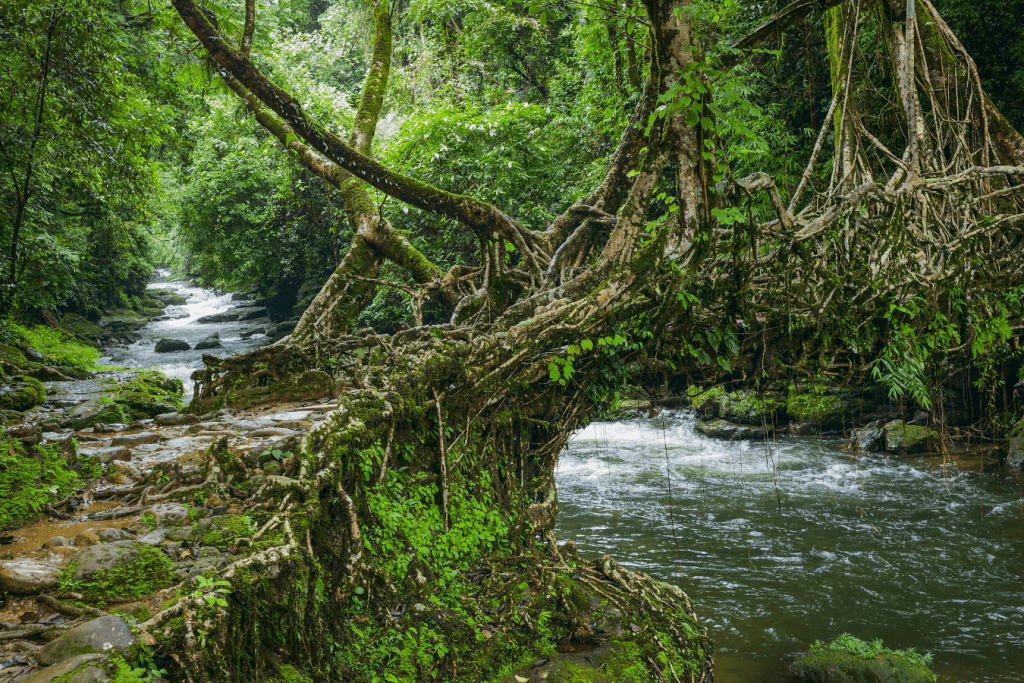
Try to avoid the monsoon season (June to September). Although the forest looks beautiful and alive during the rains, the paths can get muddy and slippery, and some treks may be difficult or even dangerous.
So, if you want to enjoy a safe, scenic, and peaceful experience, plan your trip in the cooler, drier months. That way, you can fully enjoy the beauty of the bridges—and the journey to reach them.
Activities to Do Around the Living Root Bridges
A trip to the Living Root Bridges is not just about reaching the bridge—it’s about enjoying everything the journey offers. From nature walks to cultural experiences, here are some of the best things to do while you’re there:
Trek Through the Forest Trails
The paths leading to the root bridges take you through beautiful forests filled with stone steps, thick greenery, and the sounds of nature. The trek to the Double Decker Bridge in Nongriat is one of the most popular, with around 3,000 steps through lush surroundings. It’s a great way to connect with nature and get a bit of exercise too.
Relax in the Calm of Nature
Once you reach the bridge, slow down and enjoy the peaceful setting. You’ll hear birds, flowing streams, and the breeze in the trees. It’s a perfect place to sit quietly and take in the moment.
Take Beautiful Photos
These bridges are a dream for nature lovers and photographers. With the tangled roots, misty forests, and flowing water, there’s beauty in every direction. Bring your camera or phone—you’ll want to remember it.
Dip Your Feet in the Water
Many root bridges are near clear natural pools and small waterfalls. After the trek, it feels refreshing to dip your feet in the cool water. Some travelers even take a quick swim if the weather is right.
Try Local Snacks and Tea
You might come across small stalls or friendly locals selling simple food, fruit, or hot tea. It’s a nice way to take a break, try something new, and support the village community.
Visit Nearby Villages
After your visit to the bridge, explore nearby villages to learn more about the Khasi or Jaintia culture. The homes, people, and way of life are warm and welcoming, and it adds something special to your trip.
The Feeling of Standing on a Living Bridge
Being at the Living Root Bridges is like stepping into a quiet world far away from the noise of everyday life. As you walk through the forest, the sounds of birds, flowing water, and the rustling leaves make everything feel peaceful.
The air is cool and fresh, and the trees seem to wrap around you like a green tunnel. When you finally reach the bridge, it doesn’t feel like something built—it feels alive, like it grew there just for you to find.
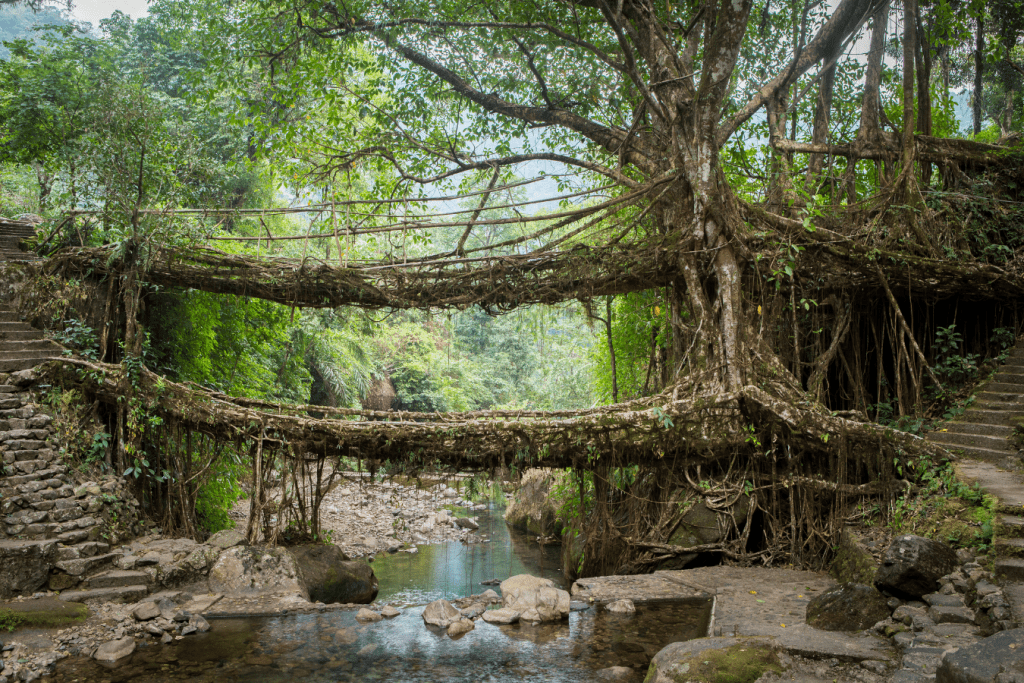
The roots are thick and strong beneath your feet, but their natural shape makes it feel magical, almost like walking through a dream. Standing on the bridge, you begin to understand how much time and care went into shaping it.
You feel connected—not just to nature, but also to the people who patiently guided the roots for years. Some visitors quietly sit nearby, others dip their feet into the cold water below, but everyone feels the same sense of wonder. It’s not just a place you visit—it’s a moment you carry with you.
Other Famous Living Root Bridges in Meghalaya
- Ritymmen Root Bridge – Easy to reach and great for a peaceful visit.
- Nongbareh Root Bridge – A quiet, offbeat spot hidden in the West Jaintia Hills.
- Mawlynnong Root Bridge – Located in Asia’s cleanest village, surrounded by scenic beauty.
Tips for Visiting Living Root Bridges
- Wear comfortable trekking shoes – The trails can be slippery, rocky, and full of steps.
- Carry enough water and light snacks – There are limited shops on the way.
- Start your trek early in the day – Some routes take several hours to complete.
- Don’t litter – Help keep the area clean and protect nature.
- Be respectful to locals – This is their home; always greet with kindness and follow local customs.
Can You Eat or Rest There?
Yes, you definitely can. After a long walk, it’s common to take a break at or near the bridges. The peaceful surroundings make it a perfect spot to rest your legs and take in the beauty around you.
In nearby villages, you’ll often find small food stalls or local tea shops where you can grab a warm drink or a light snack.
You also carry their own snacks and enjoy a quiet picnic beside the cool streams. Sitting by the water, listening to the sounds of nature, and recharging for the journey back is all part of the experience.
What Comes After the Trek?
After completing the trek to the Living Root Bridges, the adventure doesn’t have to end there. Many visitors like to cool off by dipping their feet—or even taking a short swim—in the natural pools nearby.
If you have the energy, you can continue your hike to see beautiful spots like Rainbow Falls, which is not far from the Double Decker Bridge. Local markets in the nearby villages are also worth exploring.
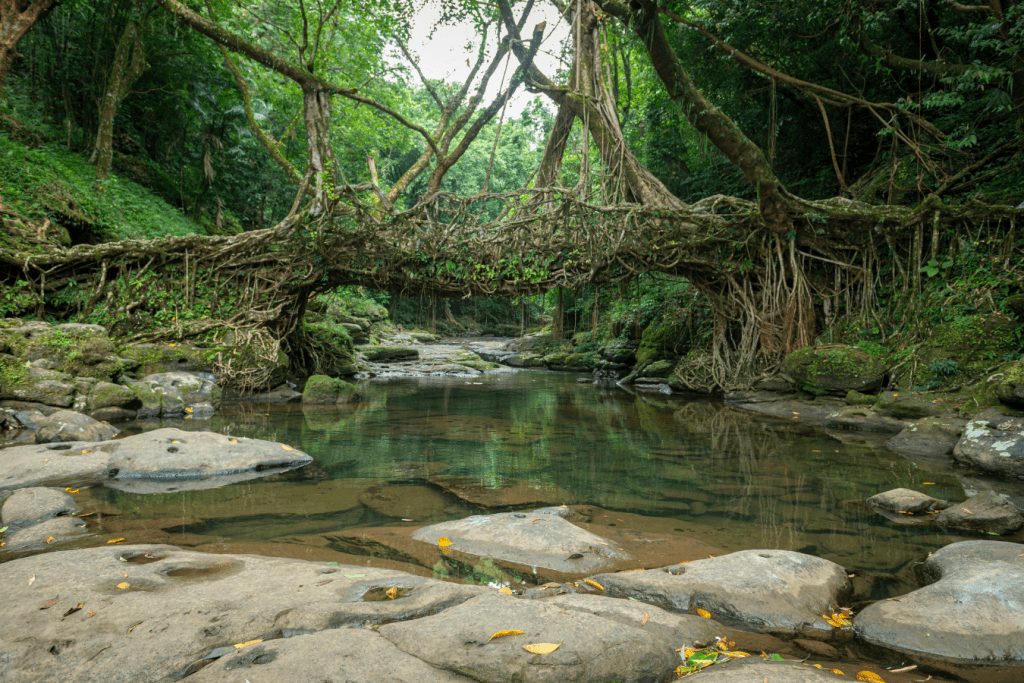
You might find handmade crafts, simple souvenirs, or tasty local snacks. If you’re not in a rush, staying overnight in a homestay or eco-lodge lets you enjoy the calm atmosphere and connect more deeply with the people and nature of Meghalaya.
Conclusion: For the Adventure in You
If you love exploring places that feel wild, real, and full of wonder—the Living Root Bridges of Meghalaya are calling you. This isn’t just another trek. It’s a journey through forests, over rivers, and deep into the heart of a culture that works with nature, not against it.
You won’t find concrete paths or fancy cafés here. Instead, you’ll find thousands of stone steps, peaceful villages, cool waterfalls, and bridges made from living roots—shaped by hand, grown by time.
So if your heart beats a little faster at the thought of misty trails, quiet green valleys, and discovering something most people have never seen—this place is for you. Pack your backpack, lace up your shoes, and let Meghalaya show you one of nature’s best-kept secrets. The adventure is real—and it’s waiting.
FAQs About Living Root Bridges in Meghalaya
1. What are Living Root Bridges?
Living Root Bridges are natural bridges made from the roots of rubber fig trees. The local Khasi and Jaintia tribes guide these roots across rivers. Over time, they grow thick and strong enough for people to walk on.
2. Where can I see them in Meghalaya?
You can find them in the Khasi and Jaintia Hills regions. Famous bridges include the Double Decker Root Bridge in Nongriat, and others in Riwai and Mawlynnong villages.
3. How long does it take to grow a root bridge?
It usually takes between 15 to 30 years for a root bridge to grow fully and become strong enough to use.
4. Is it safe to walk on these bridges?
Yes, it is safe. These bridges are very strong and some are over 100 years old. They get stronger with age and are still used by villagers every day.
5. When is the best time to visit the Living Root Bridges?
The best time to visit is from October to April. During this dry season, the weather is pleasant and the forest trails are easier and safer for trekking.
6. Do I need to be very fit to reach them?
Not necessarily. Some treks, like the one to the Double Decker Bridge, involve many steps, but most people can do it with enough rest and time. Comfortable shoes and water help a lot.
7. What else can I do nearby?
After visiting the bridges, you can explore nearby waterfalls like Rainbow Falls, relax in natural pools, visit local markets, or stay overnight in homestays to experience village life.
8. How are the Living Root Bridges being preserved today?
Organizations like the Living Bridge Foundation, supported by UNDP and local communities, are teaching younger generations the traditional root-guiding techniques, repairing older bridges, and promoting eco-friendly tourism to protect both the bridges and the surrounding forests .